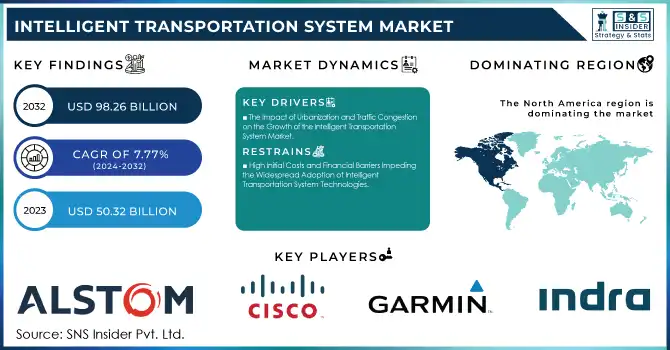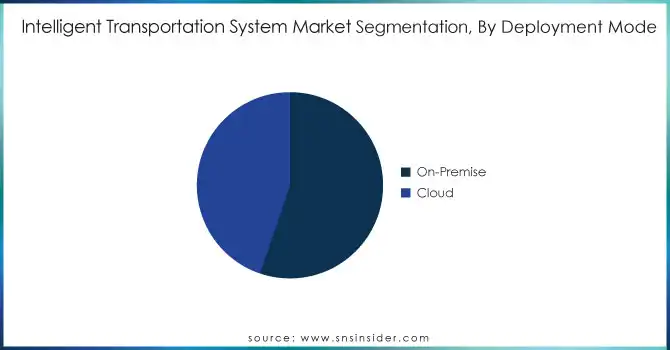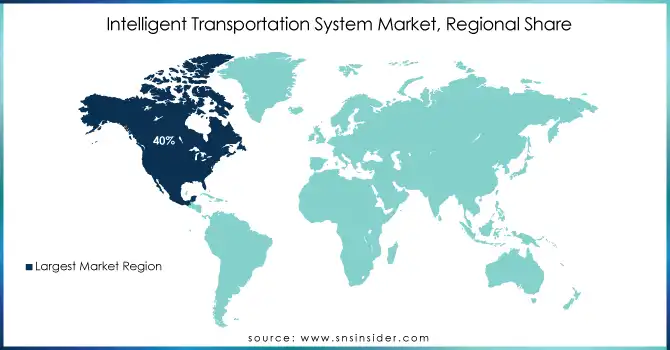Intelligent Transportation System Market Report Scope & Overview:

Get more information on Intelligent Transportation System Market - Request Sample Report
The Intelligent Transportation System Market was valued at USD 50.32 billion in 2023 and is expected to reach USD 98.26 billion by 2032, growing at a CAGR of 7.77% from 2024-2032.
The Intelligent Transportation System market is experiencing rapid growth due to the increasing need for safer, more efficient transportation networks. As cities become more congested, there is a rising demand for advanced technologies that can alleviate traffic, improve road safety, and enhance overall mobility. By 2023, connected car penetration in the U.S. was projected to exceed 50%, reflecting the growing adoption of connected vehicles, which are pivotal in enhancing real-time communication and improving traffic flow. This demand has also led to the widespread adoption of smart traffic signals and real-time data analytics, all of which work together to optimize transportation systems and make them more efficient. In 2024 the U.S. Department of Transportation announced over $130 million in grant awards for 42 technology demonstration projects through the Strengthening Mobility and Revolutionizing Transportation Grants Program, further driving innovation in the sector. These technologies not only address current transportation challenges but also lay the foundation for a more integrated, responsive infrastructure in the future.
The growth of ITS solutions is further fueled by the integration of emerging technologies such as the Internet of Things, Artificial Intelligence, and big data analytics. These innovations enable real-time monitoring and decision-making, which significantly improves traffic management and road safety by reducing congestion and minimizing accidents. For instance, in December 2024, the Texas Department of Transportation introduced an AI Strategic Plan aimed at enhancing safety and efficiency, with 230 potential use cases. As cities and transport authorities embrace these tools, they optimize vehicle flows, thus reducing environmental impact while promoting smoother traffic experiences for commuters. In this way, the continuous evolution of ITS technologies, including AI-based solutions, contributes directly to building more sustainable and efficient transportation ecosystems.
Looking ahead, the future of the ITS market is bright, with new opportunities emerging as autonomous vehicles and 5G connectivity become more widespread. These developments will allow for more seamless communication between vehicles, infrastructure, and traffic management systems, further enhancing safety and traffic flow. The ongoing shift towards electric and sustainable vehicles also presents a new avenue for ITS solutions focused on reducing emissions and improving energy efficiency. As these trends continue to unfold, the ITS market will experience further expansion, providing innovative solutions to address the growing demands of modern transportation networks.
MARKET DYNAMICS
DRIVERS
-
The Impact of Urbanization and Traffic Congestion on the Growth of the Intelligent Transportation System Market
The rapid growth of urban populations and the resulting traffic congestion in cities create an urgent need for solutions that can optimize traffic flow and reduce delays. As cities become more crowded, the pressure on transportation infrastructure increases, leading to longer commute times, inefficient public transport systems, and higher emissions. For instance, in 2023, commuters in New York City lost an average of 101 hours to traffic congestion, according to the Global Traffic Scorecard from INRIX. This highlights the critical need for solutions to alleviate these issues. Intelligent Transportation System technologies, such as smart traffic signals, real-time route planning, and automated traffic management, play a crucial role in improving traffic coordination, reducing congestion, and enhancing the efficiency of public transportation. These technologies not only streamline vehicle movement but also contribute to a more sustainable, safer, and environmentally friendly transportation ecosystem, driving demand for advanced ITS solutions.
-
The Role of Technological Advancements in Shaping the Future of the Intelligent Transportation System Market
Rapid advancements in technologies such as 5G, artificial intelligence, big data analytics, Internet of Things, and autonomous vehicles are revolutionizing the Intelligent Transportation System market. These innovations enhance vehicle-to-vehicle and vehicle-to-infrastructure communication, creating a more connected and efficient transportation ecosystem. With 5G's ultra-fast connectivity, real-time data exchange between vehicles and infrastructure becomes seamless, improving traffic management, reducing accidents, and optimizing route planning. AI and big data enable predictive analytics, allowing transportation systems to adapt dynamically to traffic conditions. In December 2024, Google’s AI updates further boosted ITS by enhancing traffic management, optimizing routes, and improving autonomous vehicle safety through solutions like Google Maps updates and real-time data processing. As these technologies continue to evolve, they will significantly enhance the safety, efficiency, and sustainability of transportation networks, fueling growing demand for ITS solutions.
RESTRAINTS
-
High Initial Costs and Financial Barriers Impeding the Widespread Adoption of Intelligent Transportation System Technologies
The deployment of Intelligent Transportation System technologies requires substantial upfront investment in infrastructure, hardware, software, and system integration. For example, the capital cost of a conventional EV charge point is USD 14,400, while integrating safety systems like Automatic Emergency Braking in trucks can cost up to USD 5,000 per vehicle. Advanced Driver Assistance Systems for trucks can cost about USD 8,102, and optimizing battery-electric bus charging infrastructure further increases costs. These high expenses can be a significant barrier for cities and regions with limited budgets or economic challenges. Additionally, the cost of maintaining and updating ITS solutions adds to the financial burden, which may lead many municipalities to delay or forgo adoption. This financial constraint limits the potential of ITS to enhance traffic management, improve safety, and reduce congestion, posing a challenge to its widespread growth.
-
Data Privacy and Security Challenges Affecting Intelligent Transportation System Market Growth
Intelligent Transportation Systems (ITS) rely heavily on the collection and sharing of vast amounts of data, including personal travel information, vehicle movements, and traffic patterns. This raises significant concerns regarding data privacy and cybersecurity. Protecting sensitive information from breaches and misuse is paramount, as any security vulnerabilities could result in privacy violations, financial losses, and a loss of public trust. Without adequate data protection mechanisms, citizens and organizations may be hesitant to adopt ITS solutions. Furthermore, regulatory pressures around data security, such as stricter privacy laws, can create additional compliance challenges for ITS providers. As these concerns grow, they can hinder the widespread adoption and implementation of ITS technologies, limiting their potential to enhance transportation systems.
SEGMENT ANALYSIS
By Component
The Hardware segment dominated the Intelligent Transportation Systems market in 2023, capturing a significant revenue share of approximately 46%. This dominance is primarily driven by the growing need for advanced infrastructure components such as sensors, cameras, and controllers, which are essential for the functioning of ITS solutions. These hardware systems enable key functions like traffic monitoring, vehicle tracking, and real-time data processing, making them critical for smart city initiatives and urban mobility projects. As cities invest in modernizing transportation infrastructure, demand for these robust hardware components remains strong.
The Services segment is poised to grow at the fastest compound annual growth rate of about 9.61% from 2024 to 2032. This growth is fueled by the increasing demand for maintenance, consulting, and system integration services that support the deployment and ongoing optimization of ITS solutions. As more cities and transportation networks adopt ITS technologies, the need for expert services to ensure seamless operations and manage complex data systems will intensify.
By Type
The Advanced Traffic Management System (ATMS) segment led the Intelligent Transportation Systems market in 2023, capturing the largest revenue share of approximately 35%. This dominance is driven by the increasing need for real-time traffic monitoring and control to manage congestion, reduce delays, and improve road safety. ATMS technologies, including intelligent traffic signals, surveillance cameras, and dynamic message signs, enable efficient traffic flow and quick responses to incidents, making them vital for smart city projects and large-scale urban infrastructure developments.
The Advanced Public Transportation System (APTS) segment is expected to experience the fastest compound annual growth rate of around 9.98% from 2024 to 2032. This growth is fueled by the increasing adoption of smart public transit solutions that offer improved operational efficiency, enhanced passenger experience, and better route planning. With the rising focus on sustainable urban mobility and the shift towards eco-friendly transportation options, cities are investing in technologies like real-time tracking, predictive maintenance, and integrated payment systems.
By Deployment Mode
The On-Premise segment dominated the Intelligent Transportation Systems market in 2023, accounting for approximately 55% of the revenue share. This dominance is primarily attributed to the preference for local data storage and processing, particularly in regions with stringent data security and privacy regulations. On-premise solutions offer greater control over sensitive information and enable faster processing times, making them ideal for critical transportation infrastructure, such as traffic management centers and emergency response systems.
The Cloud segment is projected to grow at the fastest compound annual growth rate of around 8.73% from 2024 to 2032. This rapid expansion is driven by the increasing adoption of cloud-based technologies for their scalability, cost-effectiveness, and ease of integration. Cloud solutions enable real-time data processing, remote monitoring, and seamless updates, which are crucial for the growing demand for interconnected transportation systems. Additionally, the flexibility and lower upfront costs of cloud-based platforms make them increasingly attractive to municipalities and transportation agencies looking to optimize their operations without the heavy investment associated with on-premise infrastructure.

By Mode Of Transport
The Roadways segment dominated the Intelligent Transportation Systems market with the highest revenue share of about 47% in 2023 and is expected to grow at the fastest compound annual growth rate of about 8.60% from 2024 to 2032. This dominance is driven by the increasing reliance on roadways for transportation, especially as urbanization continues to rise globally. The demand for efficient traffic management, safety improvements, and congestion reduction on road networks is growing, making ITS technologies like smart traffic signals, vehicle tracking systems, and real-time data analytics essential for enhancing road safety and optimizing traffic flow. Looking ahead, the Roadways segment is poised for continued growth due to ongoing investments in smart city infrastructure and the need for more sustainable and efficient transportation solutions in urban areas.
REGIONAL ANALYSIS
North America dominated the Intelligent Transportation Systems market in 2023, capturing approximately 40% of the total revenue share. This dominance is attributed to the region’s well-established infrastructure, high technological adoption, and strong governmental support for smart city initiatives. The United States and Canada have been at the forefront of integrating ITS solutions to improve traffic management, road safety, and reduce congestion. Additionally, the increasing demand for autonomous vehicles and the implementation of advanced traffic management systems further bolstered the region's market leadership.
Asia Pacific is expected to grow at the fastest CAGR of 10.11% from 2024 to 2032. This rapid growth is driven by the region’s expanding urban population, increasing traffic congestion, and government investments in smart infrastructure. Countries like China, Japan, and India are heavily investing in ITS solutions to enhance transportation efficiency, improve safety, and reduce environmental impact. The rise of smart cities and rapid advancements in technology are creating significant opportunities, positioning Asia Pacific as the fastest-growing market in the ITS sector.

Need any customization research on Intelligent Transportation System Market - Enquiry Now
KEY PLAYERS
-
Alstom SA (Mobility Solutions, Transport Management Systems)
-
Cisco Systems Inc. (Cisco Connected Transportation, Cisco Smart Cities)
-
Garmin Ltd. (Garmin Drive, Fleet Management Solutions)
-
Indra Sistemas S.A. (Sitraffic, Roadway Traffic Management)
-
Kapsch Group (Kapsch TrafficCom, Tolling Solutions)
-
Northrop Grumman Corporation (Traffic Management Solutions, Automated Vehicle Systems)
-
Raytheon Technologies (Traffic Signal Controllers, Smart City Solutions)
-
Siemens AG (Siemens Mobility, Traffic Management Solutions)
-
Thales Group (Thales Traffic Management, Smart Mobility Solutions)
-
DENSO CORPORATION (ITS Products, Telematics Solutions)
-
IBM Corporation (IBM Intelligent Transportation Solutions, Traffic Data Analytics)
-
Addco LLC (Addco Traffic Control Systems, Smart City Traffic Solutions)
-
TomTom NV (TomTom Traffic, TomTom Navigation Solutions)
-
Cubic Corporation (Cubic Transportation Systems, Smart Ticketing Solutions)
-
FLIR Systems (FLIR ITS Solutions, Vehicle Detection Systems)
-
Lanner Electronics Inc. (Traffic Management Hardware, Network Solutions for ITS)
-
Advantech Co., Ltd. (ITS Platform Solutions, Traffic Data Analytics)
-
Aireon (AireonSPACE, Global Air Traffic Surveillance Solutions)
-
EFKON GmbH (Tolling Solutions, Traffic Control Systems)
-
Hitachi, Ltd. (Smart Mobility Solutions, Traffic Control Systems)
-
Iteris, Inc. (Iteris ITS Solutions, Traffic Management Systems)
-
Kongsberg (Kongsberg Traffic Management, Intelligent Transport Systems)
-
L3Harris Technologies, Inc. (L3Harris Traffic Solutions, ITS Communication Solutions)
-
Navico Group (Navico GPS Solutions, Fleet Management Systems)
-
NEC Corporation (NEC ITS Solutions, Traffic Management Systems)
-
Spire Global (Spire Traffic Data Analytics, Aviation Surveillance Solutions)
-
Teledyne Technologies Incorporated (Teledyne Traffic Solutions, Video Surveillance Systems)
Recent Developments:
-
In December 2024, Indra was selected to deploy its innovative traffic management and tolling technology on Atlanta's SR 400 Express Lanes, aiming to enhance safety, reduce congestion, and offer advanced mobility solutions through dynamic tolling and cloud-based systems.
-
In July 2024, Kapsch TrafficCom deployed an advanced Intelligent Transportation System in Ribeirão Preto, Brazil, to improve traffic flow and public safety. The system includes traffic light control, variable message signs, and a camera network, contributing to smart city development.
| Report Attributes | Details |
|---|---|
| Market Size in 2023 | USD 50.32 Billion |
| Market Size by 2032 | USD 98.26 Billion |
| CAGR | CAGR of 7.77% From 2024 to 2032 |
| Base Year | 2023 |
| Forecast Period | 2024-2032 |
| Historical Data | 2020-2022 |
| Report Scope & Coverage | Market Size, Segments Analysis, Competitive Landscape, Regional Analysis, DROC & SWOT Analysis, Forecast Outlook |
| Key Segments | • By Component (Hardware, Software, Services) • By Type (Advanced Traveler Information System (ATIS), Advanced Traffic Management System (ATMS), Advanced Transportation Pricing System (ATPS), Advanced Public Transportation System (APTS), Emergency Medical System (EMS)) • By Mode of Transport (Roadways, Railways, Waterways, Airways) • By Deployment Mode (On-Premise, Cloud) • By Application (Traffic Management, Road Safety and Security, Freight Management, Public Transport, Automotive Telematics, Parking Management, Others) |
| Regional Analysis/Coverage | North America (US, Canada, Mexico), Europe (Eastern Europe [Poland, Romania, Hungary, Turkey, Rest of Eastern Europe] Western Europe] Germany, France, UK, Italy, Spain, Netherlands, Switzerland, Austria, Rest of Western Europe]), Asia Pacific (China, India, Japan, South Korea, Vietnam, Singapore, Australia, Rest of Asia Pacific), Middle East & Africa (Middle East [UAE, Egypt, Saudi Arabia, Qatar, Rest of Middle East], Africa [Nigeria, South Africa, Rest of Africa], Latin America (Brazil, Argentina, Colombia, Rest of Latin America) |
| Company Profiles | Alstom SA, Cisco Systems Inc., Garmin Ltd., Indra Sistemas S.A., Kapsch Group, Northrop Grumman Corporation, Raytheon Technologies, Siemens AG, Thales Group, DENSO CORPORATION, IBM Corporation, Addco LLC, TomTom NV, Cubic Corporation, FLIR Systems, Lanner Electronics Inc., Advantech Co., Ltd., Aireon, EFKON GmbH, Hitachi, Ltd., Iteris, Inc., Kongsberg, L3Harris Technologies, Inc., Navico Group, NEC Corporation, Spire Global, Teledyne Technologies Incorporated. |
| Key Drivers | • The Impact of Urbanization and Traffic Congestion on the Growth of the Intelligent Transportation System Market • The Role of Technological Advancements in Shaping the Future of the Intelligent Transportation System Market |
| RESTRAINTS | • High Initial Costs and Financial Barriers Impeding the Widespread Adoption of Intelligent Transportation System Technologies • Data Privacy and Security Challenges Affecting Intelligent Transportation System Market Growth |

